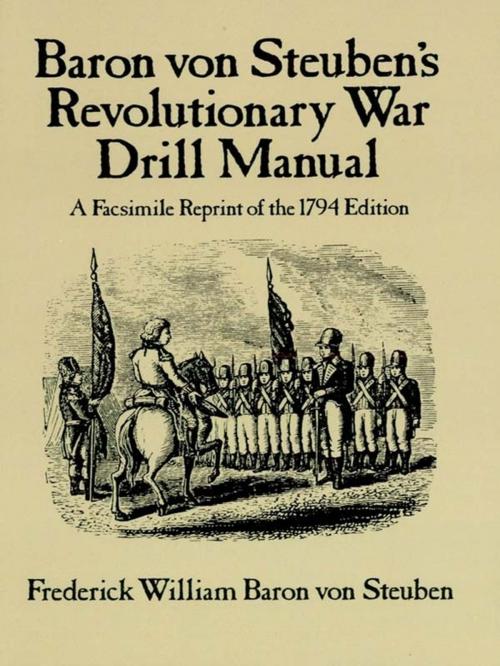Baron Von Steuben's Revolutionary War Drill Manual
A Facsimile Reprint of the 1794 Edition
Nonfiction, History, Military, Americas, United States| Author: | Frederick William Baron von Steuben | ISBN: | 9780486141350 |
| Publisher: | Dover Publications | Publication: | May 4, 2012 |
| Imprint: | Dover Publications | Language: | English |
| Author: | Frederick William Baron von Steuben |
| ISBN: | 9780486141350 |
| Publisher: | Dover Publications |
| Publication: | May 4, 2012 |
| Imprint: | Dover Publications |
| Language: | English |
On February 23, 1778, Frederick William Baron von Steuben reported to General George Washington at the Continental Army's bleak winder encampment at Valley Forge. Speaking virtually no English and at an unexpected ebb in his professional fortunes, Steuben nevertheless brought a depth of military training and grasp of command techniques sorely needed by the bedraggled, ragtag army. With his lofty military reputation, forceful bearing, and colorful personality, the Prussian commander had an immediate galvanizing effect on the disorganized insurgents. He soon became one of Washington's most valued officers — an essential figure in the success of the American War of Independence.
Commissioned to mold the troops into an efficient fighting force, Steuben formed a model drill company of one hundred men, transformed it into a precision unit copied throughout the ranks, and captured the imagination of the entire army. His record of drill instructions, written in brief installments, grew into the Regulations for the Order and Discipline of the Troops of the United States. Commonly known as the army's "blue book," this basic manual of military training and procedures remained the official U.S. military guide until 1812.
This inexpensive facsimile reproduces the extremely rare 1794 edition of Steuben's drill manual, published in Boston by I. Thomas and E. T. Andrews. It describes in detail the arms and accoutrements of officers and soldiers, formation and exercise of a company, instruction of recruits, formation and marching of columns, disposition and firing of fieldpieces, laying out of a camp, inspection, treatment of the sick, reviews of parade, and other essentials. The volume is further enhanced by reproductions of the eight copperplates from the 1794 edition and an Appendix (the United States Militia Act of 1792).
Commissioned to mold the troops into an efficient fighting force, Steuben formed a model drill company of one hundred men, transformed it into a precision unit copied throughout the ranks, and captured the imagination of the entire army. His record of drill instructions, written in brief installments, grew into the Regulations for the Order and Discipline of the Troops of the United States. Commonly known as the army's "blue book," this basic manual of military training and procedures remained the official U.S. military guide until 1812.
This inexpensive facsimile reproduces the extremely rare 1794 edition of Steuben's drill manual, published in Boston by I. Thomas and E. T. Andrews. It describes in detail the arms and accoutrements of officers and soldiers, formation and exercise of a company, instruction of recruits, formation and marching of columns, disposition and firing of fieldpieces, laying out of a camp, inspection, treatment of the sick, reviews of parade, and other essentials. The volume is further enhanced by reproductions of the eight copperplates from the 1794 edition and an Appendix (the United States Militia Act of 1792).
On February 23, 1778, Frederick William Baron von Steuben reported to General George Washington at the Continental Army's bleak winder encampment at Valley Forge. Speaking virtually no English and at an unexpected ebb in his professional fortunes, Steuben nevertheless brought a depth of military training and grasp of command techniques sorely needed by the bedraggled, ragtag army. With his lofty military reputation, forceful bearing, and colorful personality, the Prussian commander had an immediate galvanizing effect on the disorganized insurgents. He soon became one of Washington's most valued officers — an essential figure in the success of the American War of Independence.
Commissioned to mold the troops into an efficient fighting force, Steuben formed a model drill company of one hundred men, transformed it into a precision unit copied throughout the ranks, and captured the imagination of the entire army. His record of drill instructions, written in brief installments, grew into the Regulations for the Order and Discipline of the Troops of the United States. Commonly known as the army's "blue book," this basic manual of military training and procedures remained the official U.S. military guide until 1812.
This inexpensive facsimile reproduces the extremely rare 1794 edition of Steuben's drill manual, published in Boston by I. Thomas and E. T. Andrews. It describes in detail the arms and accoutrements of officers and soldiers, formation and exercise of a company, instruction of recruits, formation and marching of columns, disposition and firing of fieldpieces, laying out of a camp, inspection, treatment of the sick, reviews of parade, and other essentials. The volume is further enhanced by reproductions of the eight copperplates from the 1794 edition and an Appendix (the United States Militia Act of 1792).
Commissioned to mold the troops into an efficient fighting force, Steuben formed a model drill company of one hundred men, transformed it into a precision unit copied throughout the ranks, and captured the imagination of the entire army. His record of drill instructions, written in brief installments, grew into the Regulations for the Order and Discipline of the Troops of the United States. Commonly known as the army's "blue book," this basic manual of military training and procedures remained the official U.S. military guide until 1812.
This inexpensive facsimile reproduces the extremely rare 1794 edition of Steuben's drill manual, published in Boston by I. Thomas and E. T. Andrews. It describes in detail the arms and accoutrements of officers and soldiers, formation and exercise of a company, instruction of recruits, formation and marching of columns, disposition and firing of fieldpieces, laying out of a camp, inspection, treatment of the sick, reviews of parade, and other essentials. The volume is further enhanced by reproductions of the eight copperplates from the 1794 edition and an Appendix (the United States Militia Act of 1792).















